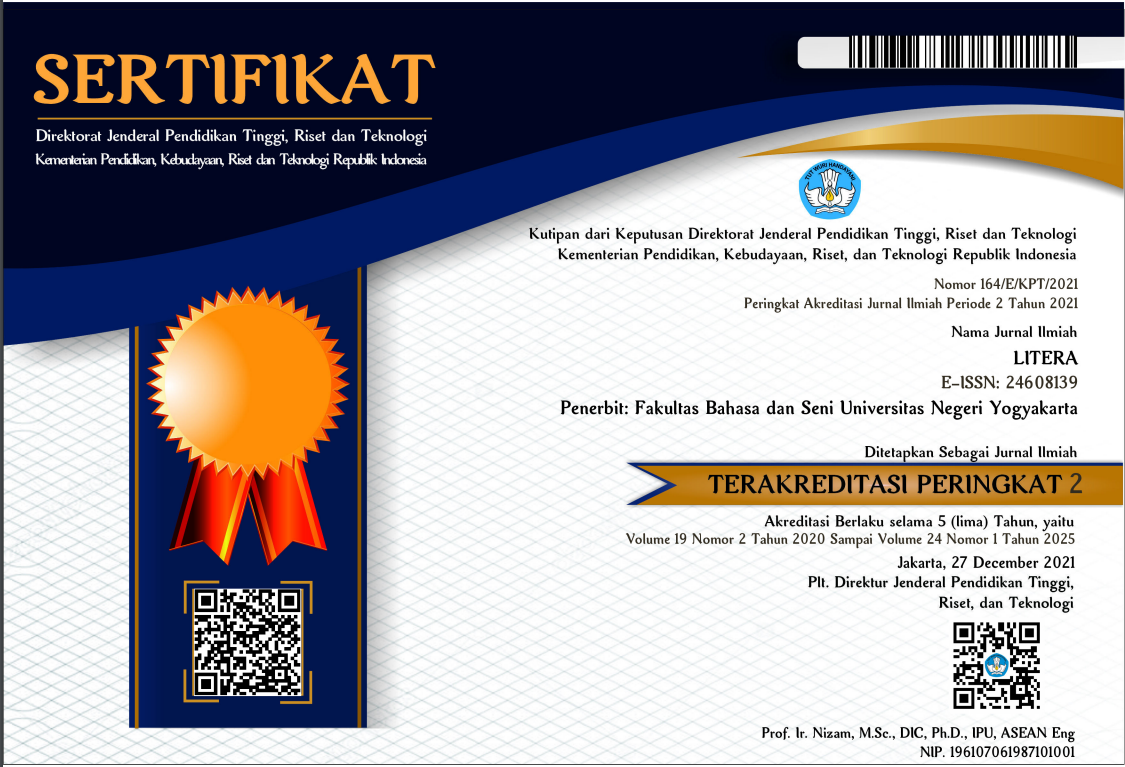WACANA HUMOR DALAM MEME DI MEDIA ONLINE SEBAGAI POTRET KEHIDUPAN SEBAGIAN MASYARAKAT INDONESIA
Abstract
This study aims to describe themes and topics, implicatures, and language aspects in
humor discourse in memes in online media. The study employed the descriptive research
design. The data sources were 70 memes in four sites of online meme media, i.e. www.
memecomicindo.com,www.indomeme.com, www.memecomic.id, and www.1cak.com.
The results of the study are as follows. First, there are four meme themes in online media;
they are social, political, legal, and religious themes. Second, there are three implicatures in
memes in online media, namely insinuation, suggestion, and the combination of insinuation
and suggestion. Third, there are two language aspects that support implicatures and result
in humor in memes, namely the phonological and semantic aspects. The phonological
aspect includes the repetition of sounds which in literature is often called a rhyme. The
semantic aspect comprises the repetition of words and the use of similes, metaphors,
hyperboles, personifications, syllogisms, abbreviations, and proverbs.
Keywords: themes, topics, implicatures, language aspects, memes
Full Text:
PDFReferences
Allifiansyah, Sandy. “Kaum Muda, Meme,
dan Demokrasi Digital di Indone-
sia”. Jurnal Ilmu Komunikasi, Volume
, Nomor 2 Desember 2016, halaman
-164. Diunduh dari https://
ojs.uajy.ac.id/index.php/jik/article/
viewFile/676/765, pada tanggal 30
Maret 2017.
Bauckhage, Christian. 2011. “Insight into
Internet Memes”. Proceedings of the
Fifth International AAAI Conference
on Weblogs and Social Media. Diunduh
dari
http://www.aaai.org/ocs/
index.php/ICWSM/ICWSM11/paper/
viewFile/2757/3304
Brown, Gillian dan George Yule. 1996.
Analisis Wacana. Edisi terjemahan oleh
I Soetikno. Jakarta: gramedia Pustaka
Utama.
Danandjaja, James. 1986. Folklor Indonesia:
Ilmu Gosip, Dongeng, dan Lain-Lain.
Jakarta: Pustaka Grafiti Press.
Departemen Pendidikan Nasional. 2005.
Kamus Besar Bahasa Indonesia. Jakarta:
Balai Pustaka.
Echols, John dan Hasan Shadily. 1984.
Kamus Inggris-Indonesia. Jakarta: Gramedia.
Eriyanto. 2006. Analisis Wacana: Pengantar
Analisis Teks Media. Yogyakarta: LkiS
Pelangi Aksara.
Mulyana. 2005. Kajian Wacana. Yogyakarta:
Tiara Wacana.
Nugraha, Aditya, dkk. 2015. “Fenomena
Meme di Media Sosial: Studi Etnografi
Virtual Posting Meme pada Pengguna
Media Sosial Instagram”. Jurnal Sosioteknologi,
Volume 14, Nomor 3,
Desember 2015, halaman 237-245. Di-
unduh dari http://journals.itb.ac.id/index.php/sostek/article/view/1558/1069
pada
tanggal 30 Maret 2017.
Nurgiyantoro, Burhan. 2012. Teori Pengkajian
Fiksi.
Yogyakarta:
Gadjah
Mada
University
Press.
Pusanti, Rosa Redia dan Haryanto. “Representasi
Kritik dalam Meme Politik
(Studi Semiotika Meme Politik dalam
Masa
Pemilu
pada
Jejaring
Sosial
“Path” sebagai Media Kritik
di Era Siber”. Diunduh dari http://
www.jurnalkommas.com, tanggal 15
Februari 2017.
Rani, Abdul, dkk. 2004. Analisis Wacana:
Sebuah Kajian Bahasa dalam Pemakaian.
Malang: Banyumedia Publishing
Sayuti, Suminto A. 2000. Berkenalan de-
ngan Prosa Fiksi. Yogyakarta: Gama
Media.
Shifman, Limor. 2013. “Memes in a Digital
World: Reconciling with a Conceptual
Troublemaker”. Journal of ComputerMediated
Communication,
Volume
,
Issue
, Version of Record Online
Maret 2013. Diunduh dari http://
onlinelibrary.wiley.com/doi/10.1111/
jcc4.12013/pdf
Wijana, I Dewa Putu. 2004. Kartun: Studi
tentang Permainan Bahasa. Yogyakarta:
Ombak.
Yule, George. 2006. Pragmatics. England:
Oxford University Press (terjemahan
dalam bahasa Indonesia oleh Indah
Fajar Wahyuni, dengan judul Pragmatik).
Yogyakarta:
Pustaka Pelajar.
DOI: https://doi.org/10.21831/ltr.v16i1.14251
Refbacks
- There are currently no refbacks.
______________________
__________________________________________________________________________________________________
Litera Journal is published by the Faculty of Languages, Arts, and Culture Universitas Negeri Yogyakarta in collaboration with Himpunan Sarjana Kesusasteraan Indonesia (HISKI)
The International Journal of Linguistic, Literature, and Its Teaching at http://http://journal.uny.ac.id/index.php/litera/ is licensed under a Creative Commons Attribution-ShareAlike 4.0 International License
__________________________________________________________________________________________________















